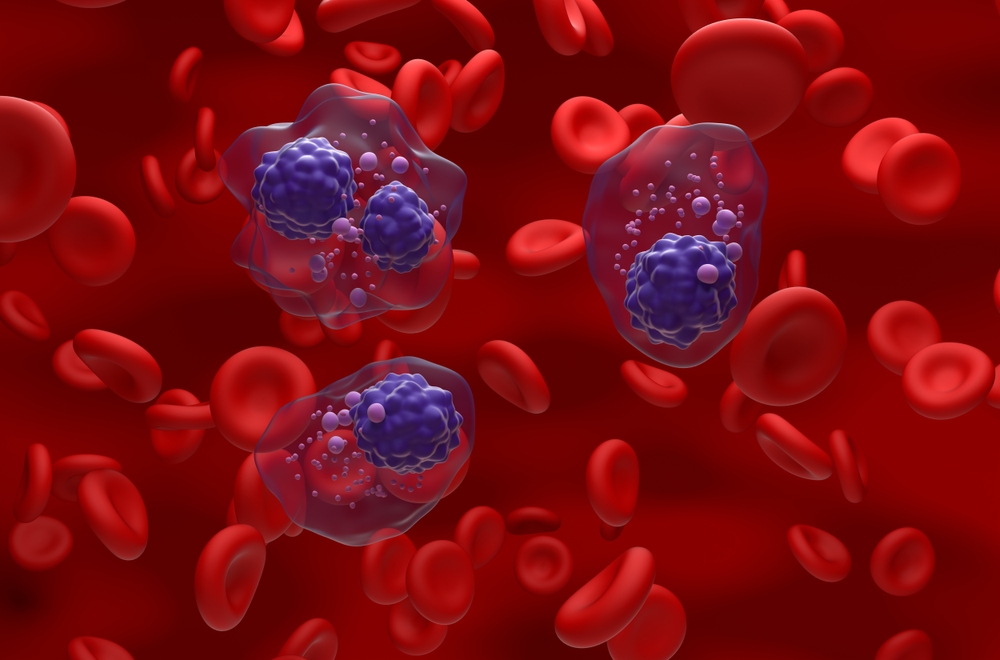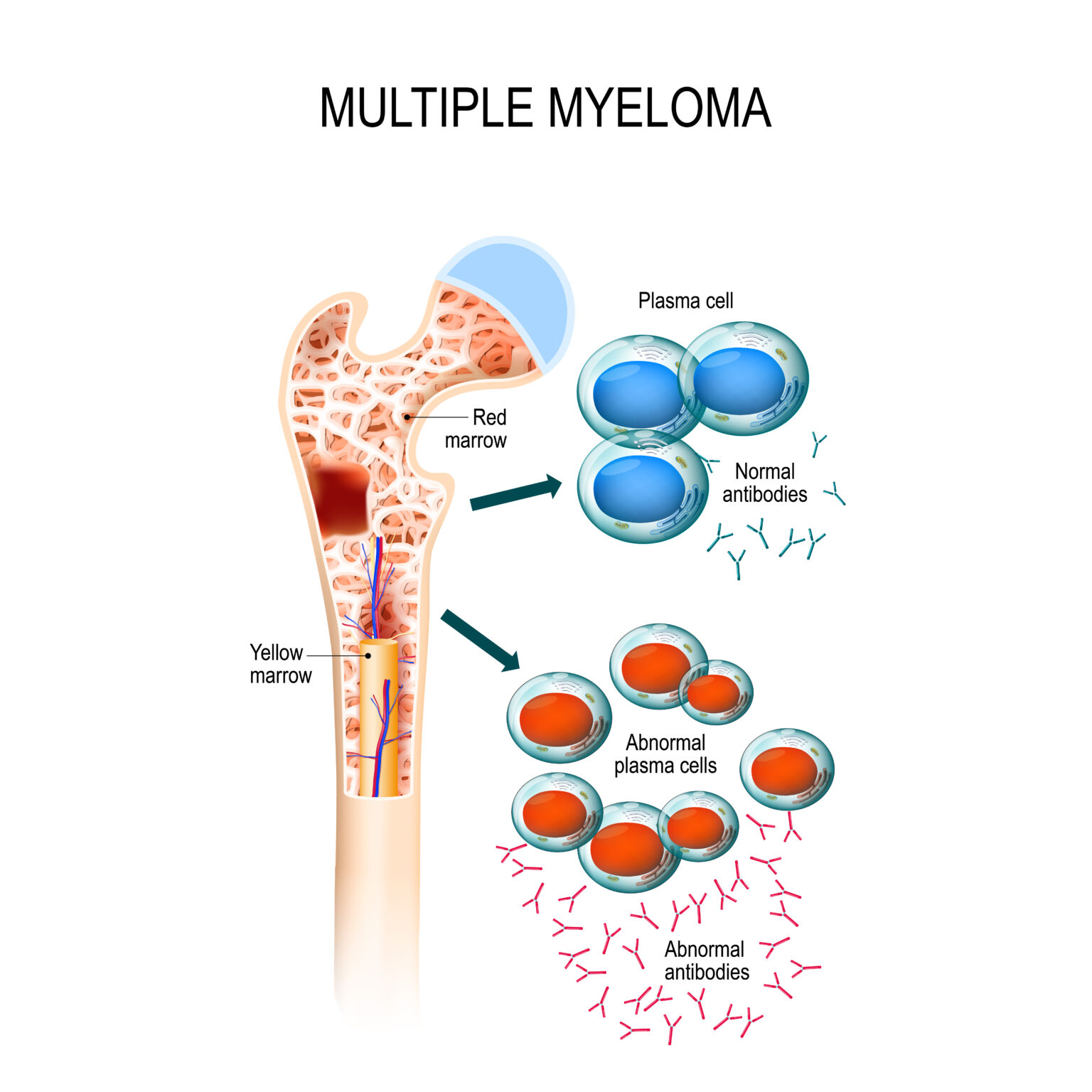Among these are some white blood cells known as B lymphocytes, which usually have the power to transform into plasma cells and produce antibodies – protective proteins ready for battle against intruders like viruses in our bodies.
Multiple myeloma develops due to abnormalities transforming B lymphocytes into plasma cells in the bone marrow. Cancerous transformation of plasma cells results in their uncontrolled multiplication and secretion of large amounts of abnormal antibodies. These abnormal antibodies don’t work. At the same time, myeloma reduces the number of normal plasma cells and normal antibodies, making people with myeloma more prone to infections. Excessive numbers of these antibodies cause myeloma symptoms, such as bone pain or kidney damage. Also, too many plasma cells crowd out other cells in the bone marrow – including cells responsible for producing red blood cells and platelets, which causes their deficiency in the body.
Typically, plasma cells are different from each other and produce different types of antibodies – so they are polyclonal. Abnormal plasma cells come from one abnormal cell – therefore, they secrete the same form of immunoglobulin and are called monoclonal.

How Common Is It?
Multiple myeloma is not a common disease. It accounts for 1.8% of newly diagnosed cancers annually in the United States. It is diagnosed slightly more often in men than in women and is most common among people over the age of 70. According to the CDC, this type of cancer is almost twice as common among African Americans compared to other races.
Symptoms
In multiple myeloma, symptoms are caused by the growth of cancer cells and the antibodies they produce:
- General symptoms usually appear, such as feeling very tired
- Bone pain – This is the most common symptom of myeloma. The pain is usually located in the lumbar region, pelvis, and ribs, rarely affecting the skull and long bones. It results from bone infiltration and destruction and the formation of pathological fractures.
- Nausea and vomiting may be caused by high levels of calcium in the blood
- Weight loss
- Fever for no known reason
- Frequent infections
- Easy bruising and nosebleeds – in multiple myeloma, there is a reduction in the production of platelets, which under normal conditions help the blood clot.
- Lack of appetite and increased thirst – these symptoms may appear in the case of high calcium levels in the blood.
- Neurological symptoms – Neurological symptoms are also quite common in multiple myeloma. They occur as a result of pressure on the nerves caused by pathological bone fractures or are caused directly by a cancerous tumor. Weakness or paralysis of muscles or urinary incontinence are observed. Sometimes, neuropathy is also diagnosed, which manifests itself as impaired skin sensation and muscle function.
How Does It Affect The Body?
During multiple myeloma, various changes occur in the body.
- Anemia – When abnormal plasma cells occupy the bone marrow, they cause other cells that produce blood cells to have no room. For this reason, too few red blood cells are produced, resulting in anemia.
- Bone pain – Myeloma cells secrete substances that cause increased bone destruction. Under normal circumstances, your bones contain osteoblasts (bone-forming cells) and osteoclasts (bone-destroying cells), and they work together to remodel the bone and allow it to regenerate. In myeloma, bone-destroying cells are overstimulated, causing the bone to become weak. This causes osteolytic changes, fractures, and bone pain.
- Infections – During myeloma, the production of normal white blood cells and other immune system cells is also impaired. Additionally, abnormal antibodies produced by the plasma cells don’t work properly. This makes sick people more susceptible to infections such as pneumonia.
- Kidney damage – Kidneys are organs that filter blood from waste substances. In myeloma, plasma cells secrete large amounts of antibodies that circulate in the blood and settle in the kidneys, causing kidney damage.
- Hypercalcemia – Large amounts of calcium are released into the blood during bone destruction. This causes symptoms of hypercalcemia, such as excessive thirst, nausea, and vomiting.
- Thrombocytopenia – Crowding out platelet-making cells in the bone marrow by cancerous cells results in too few platelets. Platelets help the blood clot, so too little leads to bruising and nosebleeds.
- Hyperviscosity syndrome – Too many antibodies in the blood (produced by abnormal plasma cells) lead to blood thickening, called hyperviscosity syndrome. For this reason, your heart must pump blood harder than usual.
- Cryoglobulinemia – Too many antibodies in the blood can cause them to stick together during cold conditions. This causes symptoms such as vasculitis, blue fingers, and skin ulcers.
- Amyloidosis – Excess antibodies in the course of myeloma can cause their deposition in various organs, including the heart and liver, causing their destruction.

Causes
The cause of the disease is unknown. A role in its development is attributed to genetic factors and long-term antigen stimulation (antigens are triggers such as microorganisms) in bacterial or viral infections. Long-term exposure to radiation, insecticides, benzene, and other toxic substances used in the chemical industry may be significant.
Multiple myeloma usually develops in stages. As a result of the mutation, an immortal plasma cell is created. It begins to divide and produce monoclonal antibodies. This stage is called monoclonal gammopathy of undetermined significance (MGUS). This stage may or may not progress further and lead to multiple myeloma.
Risk Factors
The risk factors for getting multiple myeloma include:
- Age – most people with this disease are over the age of 70.
- Sex – men get myeloma slightly more often than women.
- Race – Black people are almost twice as frequently affected by myeloma compared to other races.
- Genetic factors – if you have a family history of multiple myeloma, you are more prone to getting it, too.
- Having a condition named monoclonal gammopathy of undetermined significance (MGUS) – MGUS has low concentrations of monoclonal antibodies in the body and can progress into multiple myeloma. It usually has no symptoms and is found by chance during routine blood tests.
Diagnosis
Diagnosing multiple myeloma requires scrutiny involving a review of symptoms, a physical exam, and supplemental tests. Confirming the presence or absence of this disease necessitates thorough testing – from blood work to urine samples and imaging procedures. Each patient with suspected multiple myeloma must navigate through these extensive examinations. Following confirmation, further assessments are required to evaluate the cancer’s stage, which helps determine treatment options.
Blood tests
Blood analysis performed when myeloma is suspected includes complete blood count, creatinine level, protein level, calcium level, and lactate dehydrogenase (LDH).
Characteristic results in blood tests in the course of myeloma are increased levels of calcium and protein with the presence of antibodies typical for myeloma. The concentration of beta-2-microglobulin (a protein found in the plasma cells) is also assessed to estimate the disease’s advancement and aggressiveness. Additionally, anemia and a decrease in the number of platelets are observed.
Urinalysis
A urinalysis is performed to inform your doctor about how your kidneys function. Therefore, creatinine, urea, and calcium levels are tested. Proteinuria (a large amount of protein in the urine) is common in advanced disease. The level of Bence-Jones protein, which consists of parts of antibodies filtered through urine, is also checked. To test your Bence-Jones protein level, your doctor may ask you to collect your urine at home for 24 hours.
Scans
Scans (X-rays or CT scans) of almost the entire skeletal system (skull, spine, sternum, ribs, pelvis, arm, and leg bones) are performed to determine whether the cancer caused bone damage. Such examination should be performed on every patient diagnosed with multiple myeloma because the diagnosis of bone damage may have an impact on the treatment.
Other scans performed in myeloma are magnetic resonance imaging (MRI) and positron emission tomography (PET) scans. These tests are performed to look for individual groups of abnormal plasma cells in the body.
Bone Marrow Biopsy
A bone marrow biopsy reveals the size of plasma cell infiltrates and determines the percentage of cancer cells in the marrow. The marrow is usually harvested from the hip bone or sternum.
The biopsy is performed using a special needle. After local anesthesia, the needle is inserted through the skin, subcutaneous tissue, and bone. When the needle is in the center of the bone, the doctor connects a syringe to which the bone marrow is aspirated. The collected bone marrow is quickly placed in test tubes and microscope slides. The entire procedure takes a few minutes. The sample looks like blood but also contains small lumps of bone marrow. Typically, several milliliters of bone marrow are collected.
Stages
Based on the obtained results, the doctors can distinguish the stage of multiple myeloma. They use a three-point scale to evaluate the result of beta-2-microglobulin levels, albumin (protein) levels, and LDH levels. The stage of myeloma tells the doctors how quickly the cancer is growing. At stage 1, myeloma is slowly increasing, and at stage 3, it spreads fast.
Myeloma-like Conditions
In addition to multiple myeloma, tests can also detect:
- Monoclonal gammopathy of undetermined significance (MGUS)
- Smoldering multiple myeloma (SMM)
These are pre-cancerous diseases that may or may not develop into cancer. In such a case, further observation and regular examinations are recommended to initiate treatment immediately if the condition develops.
However, monoclonal antibodies do not always indicate cancer or pre-cancerous disease. Monoclonal antibodies can be detected in other conditions, e.g., autoimmune, rheumatological, or infectious.
Treatment
Myeloma is a disease with various forms. Full-blown multiple myeloma is most often a disease of the entire body, with a chronic course. But sometimes, it may also take the form of an isolated tumor. The form of the disorder has a crucial impact on the treatment method, but equally important factors are the patient’s age, general condition, and other diseases.
Treatment options for multiple myeloma include:
- Chemotherapy is used in the battle against myeloma, specifically to eliminate harmful plasma cells.
- Radiation therapy can offer a source of comfort for those experiencing pain from bone damage.
- Steroids – They destroy cancerous cells while also reducing inflammation.
- Painkillers – These become crucial since severe suffering from bone damage strikes during this illness.
- Antibiotics – Due to frequent infections experienced throughout multiple myeloma’s course, antibiotics might occasionally be necessary.
- Immunotherapy is a treatment that stimulates the immune system.
Medicines
Indications for drug treatment – chemotherapy and the administration of other drugs are the diagnosis of symptomatic multiple myeloma. In recent years, many new medications have been introduced that work differently than traditional chemotherapy.
Corticosteroids are also used in therapy. They work by enhancing the effects of chemotherapy and helping to destroy cancer cells.

Stem Cell Transplant
Eligible patients are treated with very high doses of drugs that are intended to destroy more cancer cells. This does not result in a complete cure but allows for a more extended period of remission, i.e., when the disease does not cause symptoms. However, such high doses of drugs do not only affect myeloma cells but also destroy healthy bone marrow. Therefore, after such treatment, a stem cell transplant is necessary to rebuild the damaged bone marrow.
There are two types of stem cell transplant:
- Autologous – when your own cells (collected from you before treatment) are transplanted. This type of stem cell transplant is more common.
- Allogeneic – when you receive a transplant of stem cells from a donor
Prognosis
Currently, multiple myeloma is considered an incurable disease. However, the increasingly better knowledge about this disease and the introduction of new, targeted groups of drugs allow for achieving remission and extending the life expectancy of patients.
According to the National Cancer Institute, the 5-year survival rate for myeloma patients is 60%. However, subsequent disease relapses worsen the treatment results. The most common cause of death during the disease is infection.
Prevention
There is no known way of preventing multiple myeloma as the cause of the disease is unknown. However, the factors linked to its development include exposure to radiation, insecticides, and other toxic chemicals, so staying clear of these factors is recommended.
When Should You See a Doctor?
If you experience any symptoms of multiple myeloma, such as bone pain, especially in the lumbar area, incredible fatigue, weight loss, muscle weakness, or fever of unknown origin, you should contact your GP. Your doctor will order proper tests and, if necessary, refer you to an appropriate specialist. A specialist in the treatment of blood diseases is called a hematologist.
Sources
- Centers for Disease Control and Prevention (CDC) Myeloma (2023) https://www.cdc.gov/cancer/myeloma/index.htm
- National Library of Medicine (NIH) Sara A. Albagoush; Cameron Shumway; Alexandre M. Azevedo. Multiple Myeloma (2023) https://www.ncbi.nlm.nih.gov/books/NBK534764/
- National Health Service (NHS) Multiple myeloma (2021) https://www.nhs.uk/conditions/multiple-myeloma/
- Dhodapkar MV. MGUS to myeloma: a mysterious gammopathy of underexplored significance. Blood. 2016 Dec 8;128(23):2599-2606. doi: 10.1182/blood-2016-09-692954. Epub 2016 Oct 13. PMID: 27737890; PMCID: PMC5146746. https://www.ncbi.nlm.nih.gov/pmc/articles/PMC5146746/
- National Cancer Institute Cancer Stat Facts: Myeloma https://seer.cancer.gov/statfacts/html/mulmy.html
- National Library of Medicine (NIH) Neeraj Ramakrishnan; Ishwarlal Jialal. Bence-Jones Protein (2023) https://www.ncbi.nlm.nih.gov/books/NBK541035/
- Lucas J. Rindy; Aaron R. Chambers. Bone Marrow Aspiration and Biopsy (2023) https://www.ncbi.nlm.nih.gov/books/NBK559232/
- National Cancer Institute Plasma Cell Neoplasms (Including Multiple Myeloma) Treatment –Patient Version (2023) https://www.cancer.gov/types/myeloma/patient/myeloma-treatment-pdq
- Rajkumar SV. Multiple myeloma: 2022 update on diagnosis, risk stratification, and management. Am J Hematol. 2022 Aug;97(8):1086-1107. doi: 10.1002/ajh.26590. Epub 2022 May 23. PMID: 35560063; PMCID: PMC9387011. https://www.ncbi.nlm.nih.gov/pmc/articles/PMC9387011/
- Terpos E, Christoulas D, Gavriatopoulou M, Dimopoulos MA. Mechanisms of bone destruction in multiple myeloma. Eur J Cancer Care (Engl). 2017 Nov;26(6). doi: 10.1111/ecc.12761. Epub 2017 Sep 21. PMID: 28940410. https://pubmed.ncbi.nlm.nih.gov/28940410/
- Runge JS, Pearson TL, Keren DF, Gitlin SD, Campagnaro E, Lowe L, Gudjonsson JE, Hristov AC. Multiple myeloma presenting as cryoglobulinemic vasculitis. JAAD Case Rep. 2021 Mar 29;11:81-83. doi: 10.1016/j.jdcr.2021.03.026. PMID: 33948463; PMCID: PMC8079932. https://www.ncbi.nlm.nih.gov/pmc/articles/PMC8079932/
- Ríos-Tamayo R, Krsnik I, Gómez-Bueno M, Garcia-Pavia P, Segovia-Cubero J, Huerta A, Salas C, Silvestre RÁ, Sánchez A, Manso M, Delgado L, Lahuerta JJ, Martínez-López J, Duarte RF. AL Amyloidosis and Multiple Myeloma: A Complex Scenario in Which Cardiac Involvement Remains the Key Prognostic Factor. Life (Basel). 2023 Jul 6;13(7):1518. doi: 10.3390/life13071518. PMID: 37511893; PMCID: PMC10382070. https://www.ncbi.nlm.nih.gov/pmc/articles/PMC10382070/
- Rajkumar SV, Landgren O, Mateos MV. Smoldering multiple myeloma. Blood. 2015 May 14;125(20):3069-75. doi: 10.1182/blood-2014-09-568899. Epub 2015 Apr 2. PMID: 25838344; PMCID: PMC4432003. https://www.ncbi.nlm.nih.gov/pmc/articles/PMC4432003/
- National Library of Medicine (NIH) Alexis Perez Rogers; Molly Estes. Hyperviscosity Syndrome (2023) https://www.ncbi.nlm.nih.gov/books/NBK518963/















